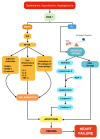Role of Terpenophenolics in Modulating Inflammation and Apoptosis in Cardiovascular Diseases: A Review
- PMID: 36982410
- PMCID: PMC10049039
- DOI: 10.3390/ijms24065339
Role of Terpenophenolics in Modulating Inflammation and Apoptosis in Cardiovascular Diseases: A Review
Abstract
One in every three deaths worldwide is caused by cardiovascular diseases (CVDs), estimating a total of 17.9 million deaths annually. By 2030, it is expected that more than 24 million people will die from CVDs related complications. The most common CVDs are coronary heart disease, myocardial infarction, stroke, and hypertension. A plethora of studies has shown inflammation causing both short-term and long-term damage to the tissues in many organ systems, including the cardiovascular system. In parallel to inflammation processes, it has been discovered that apoptosis, a mode of programmed cell death, may also contribute to CVD development due to the loss of cardiomyocytes. Terpenophenolic compounds are comprised of terpenes and natural phenols as secondary metabolites by plants and are commonly found in the genus Humulus and Cannabis. A growing body of evidence has shown that terpenophenolic compounds exhibit protective properties against inflammation and apoptosis within the cardiovascular system. This review highlights the current evidence elucidating the molecular actions of terpenophenolic compounds in protecting the cardiovascular system, i.e., bakuchiol, ferruginol, carnosic acid, carnosol, carvacrol, thymol and hinokitiol. The potential of these compounds is discussed as the new nutraceutical drugs that may help to decrease the burden of cardiovascular disorders.
Keywords: apoptosis; atherosclerosis; cardiovascular diseases (CVDs); inflammation; oxidative stress; phenolics; terpenes; terpenophenolics.
Conflict of interest statement
The authors declare no conflict of interest. The funders had no role in the design of the study; in the collection, analyses, or interpretation of data; in the writing of the manuscript, or in the decision to publish the results.
Figures



References
-
- WHO Cardiovascular Diseases. [(accessed on 15 July 2022)]; Available online: https://www.who.int/health-topics/cardiovascular-diseases#tab=tab_1.
-
- CDC Heart Disease Facts. [(accessed on 1 August 2022)]; Available online: https://www.cdc.gov/heartdisease/facts.htm.
Publication types
MeSH terms
Grants and funding
LinkOut - more resources
Full Text Sources
Medical

